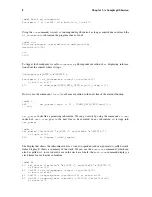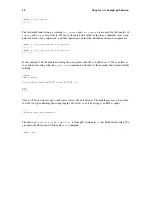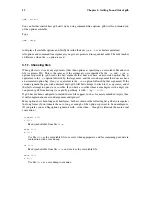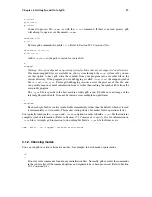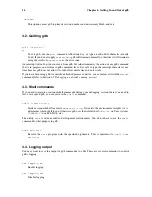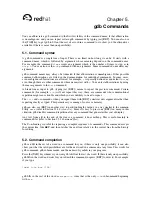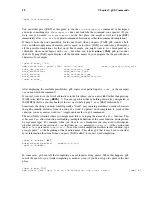
22
Chapter 5. gdb Commands
help
command
With a command name as
help
argument, gdb displays a short paragraph on how to use that
command.
apropos
args
The
apropos
args
command searches through all of the gdb commands, and their documenta-
tion, for the regular expression specified in
args
. It prints out all matches found. For example:
apropos reload
results in:
set symbol-reloading -- Set dynamic symbol table reloading
multiple times in one run
show symbol-reloading -- Show dynamic symbol table reloading
multiple times in one run
complete
args
The
complete
args
command lists all the possible completions for the beginning of a com-
mand. Use
args
to specify the beginning of the command you want completed. For example:
complete i
results in:
if
ignore
info
inspect
This is intended for use by gnu Emacs.
In addition to
help
, you can use the gdb commands
info
and
show
to inquire about the state of
your program, or the state of gdb itself. Each command supports many topics of inquiry; this manual
introduces each of them in the appropriate context. The listings under
info
and under
show
in the
Index point to all the sub-commands. Refer to
Red Hat Enterprise Linux 3
.
info
This command (abbreviated
i
) is for describing the state of your program. For example, you can
list the arguments given to your program with
info args
, list the registers currently in use with
info registers
, or list the breakpoints you have set with
info breakpoints
. You can get
a complete list of the
info
sub-commands with
help info
.
set
You can assign the result of an expression to an environment variable with
set
. For example,
you can set the gdb prompt to a $-sign with
set prompt $
.
show
In contrast to
info
,
show
is for describing the state of gdb itself. You can change most of the
things you can
show
, by using the related command
set
; for example, you can control what
number system is used for displays with
set radix
, or simply inquire which is currently in use
with
show radix
.
To display all the settable parameters and their current values, you can use
show
with no argu-
ments; you may also use
info set
. Both commands produce the same display.
Summary of Contents for ENTERPRISE LINUX 3 - SECURITY GUIDE
Page 1: ...Red Hat Enterprise Linux 3 Debugging with gdb ...
Page 12: ...2 Chapter 1 Debugging with gdb ...
Page 28: ...18 Chapter 4 Getting In and Out of gdb ...
Page 34: ...24 Chapter 5 gdb Commands ...
Page 44: ...34 Chapter 6 Running Programs Under gdb ...
Page 68: ...58 Chapter 8 Examining the Stack ...
Page 98: ...88 Chapter 10 Examining Data ...
Page 112: ...102 Chapter 12 Tracepoints ...
Page 118: ...108 Chapter 13 Debugging Programs That Use Overlays ...
Page 138: ...128 Chapter 14 Using gdb with Different Languages ...
Page 144: ...134 Chapter 15 Examining the Symbol Table ...
Page 170: ...160 Chapter 19 Debugging remote programs ...
Page 198: ...188 Chapter 21 Controlling gdb ...
Page 204: ...194 Chapter 22 Canned Sequences of Commands ...
Page 206: ...196 Chapter 23 Command Interpreters ...
Page 216: ...206 Chapter 25 Using gdb under gnu Emacs ...
Page 296: ...286 Chapter 27 gdb Annotations ...
Page 300: ...290 Chapter 28 Reporting Bugs in gdb ...
Page 322: ...312 Chapter 30 Using History Interactively ...
Page 362: ...352 Appendix D gdb Remote Serial Protocol ...
Page 380: ...370 Appendix F GNU GENERAL PUBLIC LICENSE ...
Page 386: ...376 Appendix G GNU Free Documentation License ...
Page 410: ......

